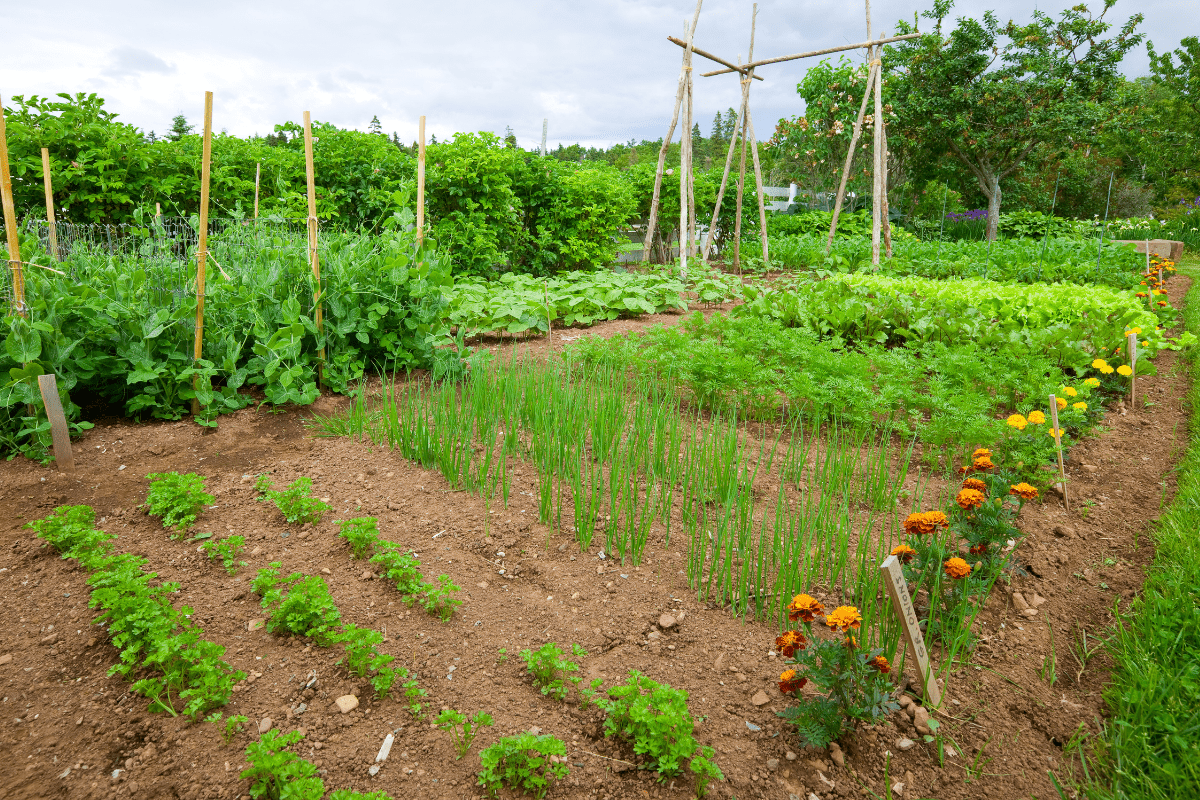Oregon's agricultural diversity feels almost unfair to other states. From coastal cranberry bogs to high desert watermelon patches, we've got growing conditions that range from "perpetual spring mist" to "surface of Mars."
Understanding Oregon's wildly different growing regions
Before you rush off to plant tomatoes in January (don't), let's talk about Oregon's five distinct growing personalities. Each region has its own quirks, frost dates, and specialty crops that make eating locally an adventure rather than a chore.
The Willamette Valley: Oregon's overachieving garden
The Willamette Valley produces most of Oregon's fruits and vegetables, blessed with 200 to 250 frost-free days annually and volcanic soil that makes plants practically leap out of the ground. This is where 90% of the world's Marionberries grow, primarily around Salem, because apparently we needed to dominate at least one berry market globally.
The valley's Mediterranean-like climate creates perfect conditions for an almost embarrassing variety of crops. Hazelnuts? We grow 99% of the U.S. supply, with harvest starting mid-September. Wine grapes thrive here, as do hops for all those IPAs Portland is famous for. The last frost typically hits around April 20, though experienced gardeners know to keep row covers handy because Oregon weather enjoys keeping us humble.
If you're gardening in the valley's USDA zones 8b to 9a, you can start planting cool-season vegetables when soil reaches 40°F in early March. Just remember that our famously dry summers mean you'll need irrigation… unless you enjoy watching your tomatoes stage a dramatic death scene by August.
Coastal Oregon: Where it's always sweater weather
The Oregon coast maintains remarkably stable temperatures year-round, creating what I like to call "eternal October" conditions. This perpetual coolness produces some unexpected agricultural stars, including 40 to 50 million pounds of cranberries annually around Bandon. Yes, that's million with an M.
Near Brookings, the southern coast grows over 95% of the world's Easter lily bulbs. Let that sink in… nearly every Easter lily you've ever seen started life in Oregon's coastal fog. The consistent moisture and deep alluvial soils create perfect bulb conditions, though slug populations also find these conditions absolutely delightful.
Coastal gardening brings unique challenges and rewards. You can grow lettuce and kale nearly year-round, but you'll need to defend them from:
- Wind that laughs at plant stakes
- Slugs with appetites of teenagers
- Moisture levels that make fungus happy
- Salt spray if you're really close
Mushroom foraging reaches its peak from September through November, when chanterelles, hedgehogs, and oyster mushrooms fruit prolifically in coastal forests. The Siuslaw National Forest allows personal-use gathering up to one gallon per day without permits, though please join a mycological society before eating anything that could potentially turn you into a cautionary tale.
Eastern Oregon: Making the most of short seasons
Eastern Oregon gardeners work with growing seasons as short as 70 days in high-elevation areas, which sounds depressing until you taste a Hermiston watermelon. These sandy-soil beauties are so renowned they're marketed with the slogan "They're Here!" from mid-July through September, and yes, they're worth the exclamation point.
The Hood River Valley benefits from Columbia Gorge influences and hosts 14,500 acres of pear orchards… the nation's largest concentration. If you've eaten a pear recently, there's a good chance it vacationed in Hood River first.
High desert gardening requires strategic thinking:
- Last frost: May 15 in Bend
- First frost: September 21 (sometimes earlier, because Oregon)
- Solution: 65-75 day varieties only
- Pro tip: Add 14 days to seed packet times
Success here means embracing season extension techniques like Wall O' Water plant protectors, which look ridiculous but work brilliantly. Focus on reliable performers like potatoes, which thrive at Klamath Basin's 4,100-foot elevation, and quick-maturing lettuce varieties that won't mind the cool nights.
Southern Oregon: Our Mediterranean wannabe
Southern Oregon's Rogue Valley enjoys the state's warmest, driest conditions with over 175 sunny days annually. To put that in perspective, the Willamette Valley gets about 80 sunny days, which explains why valley residents occasionally flee south looking slightly vitamin D deficient.
This Mediterranean climate enables crops impossible elsewhere in Oregon. Table grapes ripen reliably, olive groves produce actual oil, and fig trees bear fruit without irony. Spring arrives 2 to 3 weeks earlier than northern Oregon, and the growing season extends into November for those who plan accordingly.
USDA zones range from 7b to 9a, with the warmest areas supporting true Mediterranean plants year-round. Gardeners here should focus on drought-adapted varieties and efficient irrigation, because summer water is precious. Heat-loving vegetables like peppers, eggplant, and tomatoes absolutely thrive, often producing into October while their Willamette Valley cousins have long since given up.
Portland metro: Urban agriculture gets creative
Portland's urban agriculture scene demonstrates what happens when you combine limited space with unlimited enthusiasm. The PSU Farmers Market hosts over 140 vendors year-round, making it the state's largest market and a Saturday morning tradition for locals who enjoy coffee with their kale shopping.
Urban growing benefits from the heat island effect, which sounds apocalyptic but actually just means concrete and asphalt extend the frost-free period by several weeks. Portland gardeners successfully cultivate Asian vegetables for the city's diverse communities, with pak choi varieties maturing in 45 to 50 days and heat-tolerant long beans thriving in summer.
Container gardening maximizes limited space brilliantly. Use 5 to 10 gallon pots for tomatoes, deep containers for root vegetables, and succession plant lettuce every 2 to 3 weeks for continuous harvests. Zenger Farm's 24-acre urban farm proves you can do serious agriculture within city limits, offering CSA shares and teaching programs that inspire the next generation of urban farmers.
Following Oregon's seasonal harvest calendar
Understanding what's fresh when transforms grocery shopping from a chore into a treasure hunt. Here's your month-by-month guide to Oregon's seasonal highlights.
Spring awakening (March through May)
March in Oregon means early greens and overwintered crops finally seeing daylight again. By April, asparagus spears start poking up, especially on the coast where they sometimes appear as early as February (show-offs). Spring onions and radishes join the party, giving salads actual flavor again after months of stored vegetables.
May brings the main event: strawberries. The Willamette Valley's famous Hood variety typically peaks mid-May, and if you've only had grocery store strawberries, prepare for a religious experience. These berries actually taste like strawberries, not vaguely sweet water.
Spring flowers burst forth with enthusiasm:
- Tulips and daffodils everywhere
- Native camas in meadows
- Trilliums in shaded forests
- Cherry blossoms going viral on Instagram
Summer abundance (June through August)
June marks peak strawberry season and the beginning of raspberry madness. Hood River cherries start ripening in early July, creating traffic jams of U-pick enthusiasts who apparently don't mind purple-stained fingers.
July brings Oregon's berry supremacy into full display. Marionberries ripen alongside Chester, Columbia Star, and Kotata blackberries. Hermiston watermelons start their "They're Here!" campaign, and summer vegetables like tomatoes, peppers, and corn begin their takeover of every farmers market stall.
August represents peak everything. Vegetables overflow, early apples appear, and blueberries finally ripen for those patient enough to wait. This is when home gardeners simultaneously feel proud and overwhelmed, leading to desperate attempts to give away zucchini to anyone who makes eye contact.
Fall harvest glory (September through November)
September kicks off with hazelnut harvest mid-month, Hood River pears reaching perfection, and cranberry harvest beginning around Bandon. Mushroom foraging season starts in coastal forests, where chanterelles worth their weight in gold (almost literally at farmers markets) begin fruiting.
October brings peak apple harvest, winter squash in every shape imaginable, and late tomatoes still producing in Portland thanks to that heat island effect. This is when serious food preservers go into overdrive, pressure canners working overtime to capture the season.
November winds down the fresh harvest but offers storage crops, continuing cranberry harvest, and hardy greens that actually improve with frost. Kale becomes sweeter, Brussels sprouts lose their bitterness, and root vegetables settle in for long-term storage.
Winter persistence (December through February)
Winter doesn't mean giving up on local food. Stored apples and pears maintain quality for months when properly kept. Root vegetables from good storage taste better than anything shipped from thousands of miles away. Greenhouse operations provide fresh greens, and some coastal areas even produce year-round.
February brings hope in the form of early asparagus on the coast and the beginning of seed-starting season for everyone else. This is when gardeners stare longingly at seed catalogs and make unrealistic plans for the coming year.
Finding Oregon's seasonal produce
Knowing where to shop makes all the difference between eating seasonally and just thinking about it.
Farmers markets across the state
Portland's PSU Saturday Market operates year-round with over 140 vendors, creating a weekly festival of local food. The Hollywood Farmers Market also runs year-round on Saturdays, offering a neighborhood feel with serious vegetable variety.
Smaller cities offer excellent markets during growing season:
- Corvallis: Wednesdays and Saturdays, April-November
- Bend: Wednesdays, May-October
- Ashland: Tuesdays at ScienceWorks, March-November
- Coastal markets: Various schedules, often year-round
U-pick farms and agricultural trails
The Hood River Fruit Loop spans 35 miles and connects 30-plus farms offering seasonal U-pick experiences. June brings strawberries, July offers cherries, and August through October delivers apples and pears in overwhelming variety.
Willamette Valley U-pick farms include Smith Berry Barn near Hillsboro with over 20 berry varieties and their famous milkshakes that justify the drive. Bauman's Farm hosts an annual harvest festival complete with cider pressing demonstrations and corn mazes for those who enjoy being lost in vegetation.
Specialty trails add adventure to produce hunting. The Southern Oregon Lavender Trail connects six farms during peak bloom in late June and mid-July. Various berry festivals throughout summer celebrate Oregon's ridiculous berry diversity, and cranberry bog tours in fall offer Instagram-worthy photo opportunities.
Growing your own Oregon garden
Successfully growing food in Oregon means understanding your specific microclimate and working with it rather than against it.
Know your zone and frost dates
Oregon's USDA zones range from 4a in mountain areas to 10a on the southern coast, which basically means we have every possible growing condition except tropical. Use OSU Extension planting calendars specific to your region rather than generic advice from national magazines.
Coastal gardeners can grow cool-season crops nearly year-round. Valley gardeners should plant cool-season crops in March and warm-season after mid-April. Eastern Oregon gardeners need to focus on varieties that mature in 65 to 75 days, while Southern Oregon gardeners can successfully grow Mediterranean crops that would laugh at Portland's rain.
Water management strategies
Every Oregon region except the coast needs irrigation planning for summer. The Willamette Valley's famous summer dry spell catches new gardeners off guard every year. Southern Oregon requires especially efficient irrigation, while coastal gardeners often need raised beds to manage excess moisture.
Eastern Oregon's short season means every drop counts. Drip irrigation or soaker hoses work better than overhead watering, which loses too much to evaporation in hot, dry conditions.
Season extension techniques
Success often depends on pushing the boundaries of your natural season:
- Row covers for frost protection
- Cold frames for winter growing
- Wall O' Water for Eastern Oregon
- Succession planting for continuous harvests
- Container growing for urban spaces
Container gardening particularly suits urban growers. Use 5 to 10 gallon pots for tomatoes, deep containers for root vegetables, and don't forget drainage holes unless you enjoy root rot.
Preserving the bounty
Oregon's feast-or-famine growing seasons make food preservation essential for year-round local eating.
Canning safely and successfully
The OSU Extension Food Safety Hotline (800-354-7319) operates July through October, staffed by Master Food Preservers who prevent botulism one phone call at a time. They offer free pressure canner gauge testing annually, which is essential since inaccurate gauges can ruin food or worse.
Water bath canning works perfectly for Oregon's acidic fruits and berries. Marionberry jam, pickled peppers, and apple butter represent gateway preservation projects. Pressure canning safely preserves low-acid vegetables like green beans and corn, plus those hearty soups that make Oregon winters bearable.
Freezing for simplicity
Freezing captures peak-season quality with minimal fuss:
- Freeze berries on trays first
- Blanch vegetables before freezing
- Portion herbs in ice cube trays
- Label everything with dates
- Use within 8-12 months
Root cellaring and fermentation
Traditional root cellaring suits Oregon's climate, particularly for storing apples and root vegetables. Ideal conditions of 32 to 40°F with 85 to 90% humidity extend storage for months. Eastern Oregon's dry basements work perfectly, while coastal areas might need dehumidification.
Fermentation adds probiotics and flavor complexity. Oregon cabbage becomes sauerkraut, cucumbers transform into proper pickles, and hot peppers create unique fermented sauces that improve everything they touch.
Essential Oregon growing resources
Success requires good information, and Oregon delivers excellent resources for gardeners and food enthusiasts.
OSU Extension Service maintains offices in all 36 counties, offering soil testing, plant disease diagnosis, and Master Gardener programs. Their monthly garden calendars provide region-specific timing that generic advice can't match.
Regional seed companies understand Oregon's unique conditions:
- Territorial Seed Company in Cottage Grove
- Adaptive Seeds in Sweet Home
- Wild Garden Seed in Philomath
Portland maintains multiple seed libraries including one at PSU's Student Sustainability Center. The Portland Fruit Tree Project coordinates gleaning from urban orchards, organizing harvest parties where volunteers help collect otherwise-wasted fruit.
Making the most of Oregon's seasons
Oregon's agricultural diversity means eating seasonally never gets boring. From February's early coastal asparagus to November's stored apples, each month brings new flavors and opportunities. Understanding your region's particular quirks, whether that's defending against coastal slugs or racing Eastern Oregon's early frost, makes the difference between gardening frustration and abundance.
The key is starting where you are with what you have. Visit a farmers market this weekend. Try one new vegetable. Plant some lettuce in a container. Join a mushroom foray. Whatever you do, don't let Oregon's incredible seasonal bounty pass you by while you're eating shipped-in produce from thousands of miles away.
Our state's farmers, innovative urban gardeners, and dedicated food preservers have created a local food system that feeds us year-round. All we need to do is show up, preferably with a basket and an appetite for adventure.





